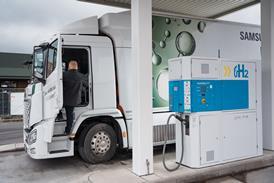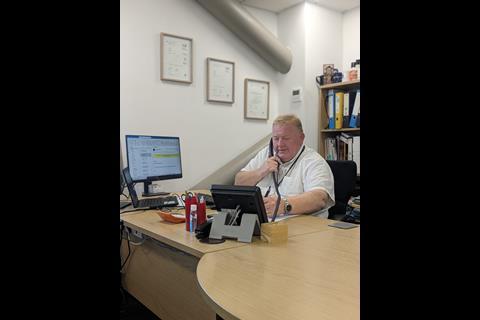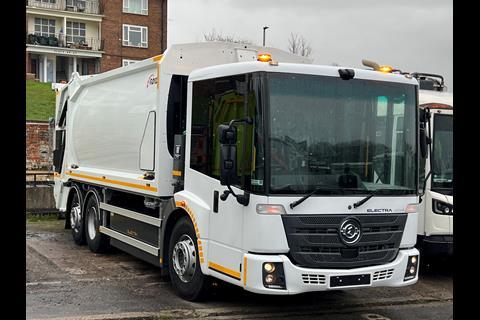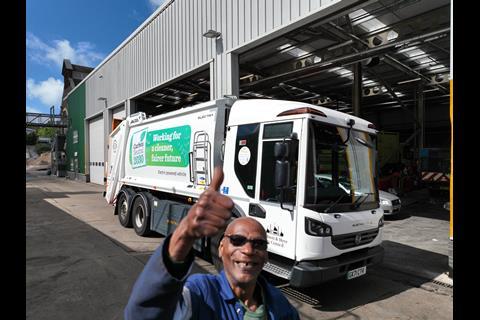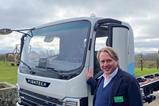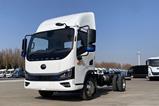In the first of our series of Freight Carbon Zero industry trailblazer interviews, we’ve been to Brighton to catch up with Ian Greene, Head of Fleet at Brighton & Hove Council, and get his insights and feedback on his journey to decarbonise the fleet of cars, vans and trucks across the council operations.
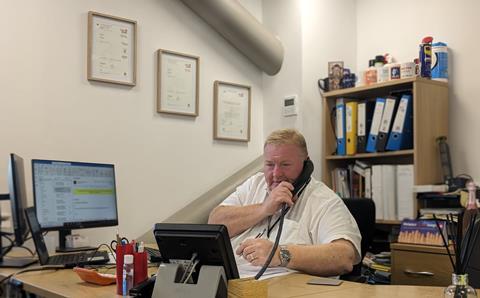
Ian Greene is heavily invested in the cause of decarbonisation, he is responsible for all aspects of the Brighton & Hove council fleet of 500 or so vehicles from procurement, through operations and service and maintenance and clearly has a passion and zest for the journey to a net zero future. Over the past four years he has set about reviewing the fleet with the target of reducing the overall number of vehicles, and most recently electrifying all aspects of the operation installing chargers, acquiring vehicles, upgrading the workshop and preparing the skills and resources the organisation will require for the journey ahead.
It was a throw-away comment from his wife, one evening that made him splutter on his wine, however: “What are you going to do when there’s a power cut?” It’s an innocuous enough question, but one that made Ian Greene splutter on his glass of wine, when his wife raised the question one evening a couple of years ago. He is passionate about the decarbonisation of the industry, but in his drive to re-power the fleet, this question had been overlooked and he spent the next couple of days furnishing a solution to keep the vehicles moving in the event of a power shut down.
”What are you going to do when there’s a power cut?”
“We couldn’t have a situation where nobody is going to get their bins emptied if there was a power cut,” he told us. “So I came in the next day and I rang up the company who was installing our charge points and asked them the same question and it was clear this was a major oversight. I asked if there was any way we could hook up a generator that could take over from the outside power. We’ve now got the means to simply plug in an emergency on-site generator which will give us the resilience and disaster recovery we require.” Providing the generator is running on HVO, or similar renewable fuel, then the low carbon merits of the fleet can be maintained, he adds.
With any significant change in operation, all those involved will be on a steep learning curve and Greene is happy to share the key lessons with us during our 90-minute interview where we talk vehicle choices, operational experiences and the service and maintenance regime expected for the electric vehicle fleet. As we’ve said, he is one of a small group of fleet engineers and managers operating at the coal face of carbon zero operations, and is working for what was, until recently a council with a strong Green Party presence. It’s now a Labour-led council, although the push to net zero remains a core policy.
“Our strategy here, is based around Government’s ambition to be carbon neutral across the public sector by 2030,” he explains. “Initially we embarked on a plan to start testing products, this was early 2020, understanding the benefits and any limitations. But we soon realised the products were available now and we could start purchasing battery electric vehicles – cars, vans and now heavy trucks.”
“We soon realised the products were available now and we could start purchasing battery electric vehicles – cars, vans and now heavy trucks.”
Interestingly, given the high capital costs of carbon zero trucks, the council prefers outright purchase to leasing or contract hire: “The cost of our borrowing against the lease costs is much smaller and therefore more financially viable,” explains Greene. “My strategy has been to depreciate the value of the vehicles over a period of time [seven for the refuse trucks] and then have some residual value left in the vehicle at the end of that period to put towards the procurement of new vehicles. Until I arrived, we were running vehicles into the ground until they were finished and so there was very little you could do with them other than sell them off for parts or scrap.”
Running a fleet of refuse trucks is an intensive operation and while the trucks might not be covering significant mileages, they are operating for eight hours a day, running to full capacity twice a day with a lot of stop-start activity. While the public sector operation and urban duty cycles, clearly lends itself to a carbon zero mission, the stop-start intensity of the operation and requirement for ancillary compaction equipment is perhaps not the most obvious application for a battery electric vehicle.
Greene admits to a certain amount of trepidation associated with electrifying the truck fleet, made slightly more complicated by the distraction of whether they should be opting for hydrogen over battery electric. “There’s a massive debate about whether it should be a hydrogen-based fleet or whether battery would be best,” he says, explaining the journey to landing at battery electric. “We [Brighton & Hove] are aiming to be a hydrogen city, so this has to be a long-term consideration, but the way I looked at it, at this point certainly for our first round of vehicles, batteries will be the most sustainable. There’s simply not enough hydrogen production in the country to sustain what we want without a massive upheaval.
“We looked at partnering with other local authorities nearby and Brighton & Hove buses. We did, and still do, a lot of work with them on becoming a hydrogen-based fleet, but I don’t see that being within the next five to seven years, just because of the availability of hydrogen.”
Greene on vehicle selection
Greene got the go ahead to start purchasing battery electric trucks in 2020 and while the diesel-powered fleet is sourced from Mercedes and Dennis Eagle he turned to Blackburn-based Electra for his battery vehicles. There are currently four battery electric trucks in operation on the fleet with seven on order and the paperwork in place to order another five which will take the replacement cycle through to 2024. Electra is building a very strong reputation for flexibility and customer focus and Greene is certainly an advocate of the company.
“One of the big advantages of Electra is their customer focused culture,” he explains. “We give them a challenge and they work with us to deliver a solution.”
Greene cites the example of a very specialist vehicle the council is putting to work to emphasise the “can do” attitude of Electra. This is a vehicle for communal waste collection, the body of which is built by Ros Roca in Spain. “We are the only local authority in the UK which runs these bin systems and it requires a 3,200-litre sideloading capability,” explains Greene. “It’s very common in France, Spain and Germany, but not so here. Ros Roca is the bodybuilder, but they had no intentions of deviating from diesel at that point. We brought Electra and Ros Roca together and between them they’ve come together and built the first electric sideloading vehicle in the country, which will go into service in December 2023.
“This is where Electra has been great, and very approachable. You can sit there and say to them, ‘this is what I want’ and pass it across the table. They’ll come back with what their recommendations are, and because we’ve used the product, and we’re familiar with it, we’re now in a position to say, yeah it will work and go ahead.”
The Electra product is performing well in service, continues Greene, and the vehicles are well suited to the Brighton operating conditions with its challenging topography on the edge of the South Downs and busy urban environment.
Greene on service and maintenance
In operation, Greene has already identified a future challenge for workshop utilisation as the fleet switches to battery electric vehicles. There are less consumable parts to manage and, so far at least, there is a reduced maintenance requirement on the battery electric vehicles – brakes are lasting longer and tyre wear is substantially reduced, he explains.
“As much as I’d love to see it, we’re never going to be in a scenario where we’re not going to have problems,” Green explains, indicating it will be very unlikely the council would contract out the vehicle maintenance. The vehicles have an expected life cycle of seven years and will need a robust service and maintenance regime to protect the residual value. More likely the workshops would be open for other third party work he says.
“We have taken the relationship with Electra a little bit further,” he continues. “We’ve now sent two of our mechanics up to Electra for two weeks where they learn how the truck gets built, how everything works on it, and how to diagnose any issues. It’s our intention to become an Electra warranty centre in the future. Electra is based in Blackburn and we’re down here with a fairly substantial workshop. It would make sense for us to offer support to other third parties.”
There aren’t many operators out there with the depth of operational experience and data that Greene enjoys and we were keen to understand if there are any key learnings from the first two years of operating the vehicles – we weren’t disappointed…
“We have taken the relationship with Electra a little bit further. We’ve now sent two of our mechanics up to Electra for two weeks where they learn how the truck gets built, how everything works on it, and how to diagnose any issues. It’s our intention to become an Electra warranty centre in the future. Electra is based in Blackburn and we’re down here with a fairly substantial workshop. It would make sense for us to offer support to other third parties.”
“We’ve been carrying out some operational comparisons between diesel and electric vehicles,” he explained, reaching for his spreadsheets. “Our council members are very interested to see how the new vehicles are performing. The running costs, including fuel, for the diesel trucks was £47,000 for the year, while the electric vehicle was £10,338. My goal was, was to show our councillors that we could be cost neutral by year seven. If you bring into account the upfront cost of the trucks [Brighton & Hove buys all its own vehicles] then we are on course to deliver that neutrality.”
Similarly, brake and tyre wear is significantly less on the electric compared to the diesel. We can understand impact of the regenerative braking on pad wear, but we were surprised by the claim on tyres. “We’re probably getting about 40% more life from the tyres,” he said. “The brake regeneration means your not putting as much forces through the tyres and, I suspect the smoother driving style is contributing.”
Furthermore, he explains, the first of the Electra’s has just gone through its second anniversary and MoT test and “we finally had to change the discs and pads on that vehicle. Ordinarily, we’d be on our third set of pads and at least the second disc. I think it’s safe to say we’re getting three times as much life out of the brakes, thanks to regeneration.”
Greene on battery management and driver training
To the uninitiated, the intensive demands of refuse vehicles you would think would put a heavy demand on the batteries and you’d need lots of them. Not so, explains Greene. There are varying sizes of battery packs available with Electra explains Greene, from 210, 280 or 350kW. “The trouble is, the more batteries you have on there, the less capacity you have to collect and carry waste,” he says. “It’s a fine balance between what you’re going to need and the payload, which obviously impacts on what waste we can collect.”
On battery selection the council has tried all battery configurations. “To be honest with you, the ones with the lower battery packs are outperforming the others,” he explains. “I’m not saying that’s going to work for everybody, but we started an intensive driver training programme to ensure we get the best efficiency out of the truck, without losing any collection and delivery performance and it seems to have paid dividends.”
This is specific driving for electric vehicles focused on how to use the regeneration to maximise battery performance. “They all love the electric trucks,” he continues. “If you put your foot down, it’s as fast as a car from a set of traffic lights, but we need to respect that we have 27 tonnes of metal on the street, you have to be very careful.
“Our training programme is about how to drive the vehicle ethically, safely, calmly, and how to save as much energy as possible. We go out on the roads and coach them on their specific delivery or collection route. To maximise battery performance our main focus is on energy management, not accelerating to harshly and making best use of the regenerative capability of the vehicle.”
While the intricacies of managing vehicle performance has meant some reskilling, the driver feedback has been very positive, continues Greene. “We trialled the first vehicles with one of our drivers who has the hilliest runs,” he says. For those who aren’t aware Brighton, perched on the edge of the south downs has some demanding terrain. “We asked him at the end of the day how it was and his first reaction was he felt really calm. Traditionally, the driver would be sitting on top of the engine and you’d have all the noise, vibration and harshness associated with working the vehicle hard during a round – that’s all gone. All you can hear now is the rubbish dropping into the hopper and the compactor. Our biggest downside is that people can’t hear us coming so we’ve had to put audible warning on the vehicles.”
Greene on infrastructure
The council worked closely with UK Power Networks to get the site connected. There was already a substation on site, explains Greene, though it was clear that wouldn’t be enough to satisfy the requirements so an additional station was commissioned giving the site a spare capacity of over 450kW to meet the future needs. What’s more the council site is implementing solar panels on the roof of the buildings. “We’ve started with a small area and are now expanding across the rest of the buildings,” he said. “On a good day we can pull 63kW from there which offsets the cost of charging the vehicles.” He also sounded a note of caution on solar panels, which may be a particular issue for Brighton with its seagulls, “you do need to keep them clean,” he quips, “or you will notice a drop in performance…”
On charging, the council has one rapid DC charger for fast response, while the rest of the set-up is 22kW 32A AC chargers for the trucks and 7kW for the smaller vehicles. “Initially, when we started with the HGVs, we thought we’d be charging them up every single day,” he tells us. “Now that we’ve focused on driver training and battery management, we’re actually now trialling and charging every third day and looking at lower capacity battery pack as well. We’ve now got to a point where someone’s picking up 22 tonne of waste a day, using just 30-35% of the battery. That’s been a big learning.”
Freight Carbon Zero saummary: We know it’s a cliché, but we get the impression every day is a school day when you’re in the business of decarbonising your fleet. The nuances of the operation, the duty cycle, the vehicles you use and how you re-fuel them will throw up new challenges, opportunities and learnings every day. We spent a couple of hours with Ian Greene, it could have been two days, such is the depth of knowledge and understanding he was willing to share. We know Ian Greene isn’t alone in his enthusiasm for the journey to decarbonisation and we’re looking forward to talking to many more in the months ahead.


